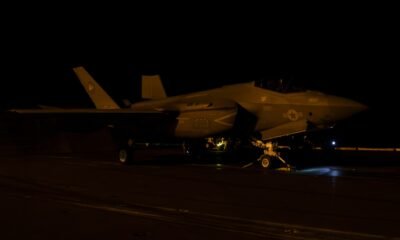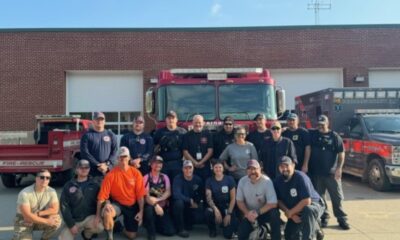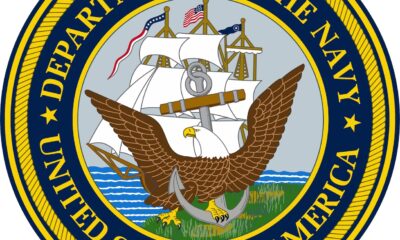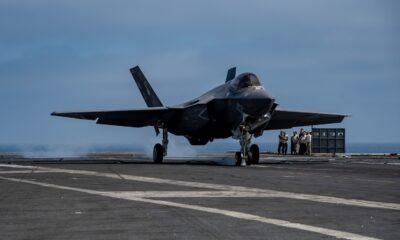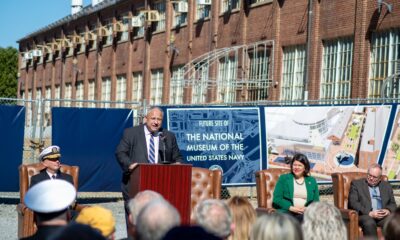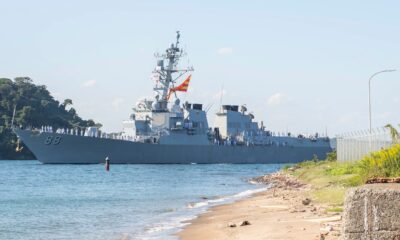All Navy Categories
VXS-1 Squadron Frontlines Hurricane Francine: Real-Time Tracking Unveiled
WASHINGTON – On Tuesday, Sept. 10, the U.S. Naval Research Laboratory’s (NRL) Scientific Development Squadron ONE (VXS-1) deployed observational buoys in the anticipated path of Hurricane Francine. The operation aimed to provide real-time updates to the National Oceanographic Partnership Program (NOPP) Hurricane Coastal Impacts (NHCI) team, enhancing prediction accuracy and operational readiness.
Known as the “Warlocks,” VXS-1 deploys environmental observation buoys ahead of hurricanes during the June to November season. The squadron responded swiftly to the evolving conditions of Hurricane Francine.
“The Warlocks work closely with NHCI project representatives to determine optimal buoy deployment coordinates for data collection,” said VXS-1 Commanding Officer Cmdr. Aaron Roberts. The squadron deployed 16 buoys off the Louisiana coast ahead of Francine’s landfall. These included four submersibles, six spotters, three Directional Wave Spectra Drifters, and three Surface Wave Instrument Floats with Tracking.
The aircrew comprised of Cmdr. Aaron Roberts, Lt. John Leyba, Lt. Avery Nwokike, Chief Petty Officer Fred Lewis, First Class Petty Officer Amanda Moreland, Second Class Petty Officer Cody Buckingham, and First Class Petty Officer Gavin Naughton in an NP-3C Orion aircraft.
“Hurricane predictions are crucial. Our small squadron of 70 personnel significantly impacts national readiness,” said VXS-1 Executive Officer Cmdr. Tony Levine. “Our Sailors’ professionalism and hard work were vital for this mission.”
The NHCI program, spanning multiple government, industry, and academic partners, comprises five tasks and ten teams. NRL’s Marine Meteorology team from Monterey, California, manages Task 0, while VXS-1 contributes operational expertise, demonstrated during the Hurricane Francine airdrop.
The Marine Meteorology team employs NRL’s Coupled Ocean-Atmosphere Mesoscale Prediction System for Tropical Cyclones (COAMPS-TC) to create detailed hindcasts of hurricanes. COAMPS-TC also provides real-time updates to NHCI teams, enhancing prediction capabilities and readiness.
“NHCI aims to predict coastal impacts during hurricane seasons from 2022-2024,” said Lt. John Leyba, VXS-1 Maintenance Officer. “These forecasts will help coastal communities prepare for extreme weather events.” VXS-1 has supported NHCI since August 2022.
The NP-3C Orion, a versatile aircraft, supports rapid integration of science and technology projects. It boasts a maximum endurance of 12 hours, a 30,000 ft. altitude capacity, and speeds ranging from 160 to 300 knots.
The aircraft features sensor-carrying capabilities in the nose and tail radomes, a configurable bomb bay equipment platform, external antenna mounting, and the ability to deploy sonobuoys.
About the U.S. Naval Research Laboratory: NRL is dedicated to innovative research for the U.S. Navy and Marine Corps. Based in Washington, D.C., it operates major field sites in Stennis Space Center, Mississippi; Key West, Florida; and Monterey, California. Employing approximately 3,000 civilian scientists and engineers, it drives advancements from the seafloor to space and in information domains.
For more information, contact NRL Corporate Communications at (202) 480-3746 or via email at nrlpao@us.navy.mil.

